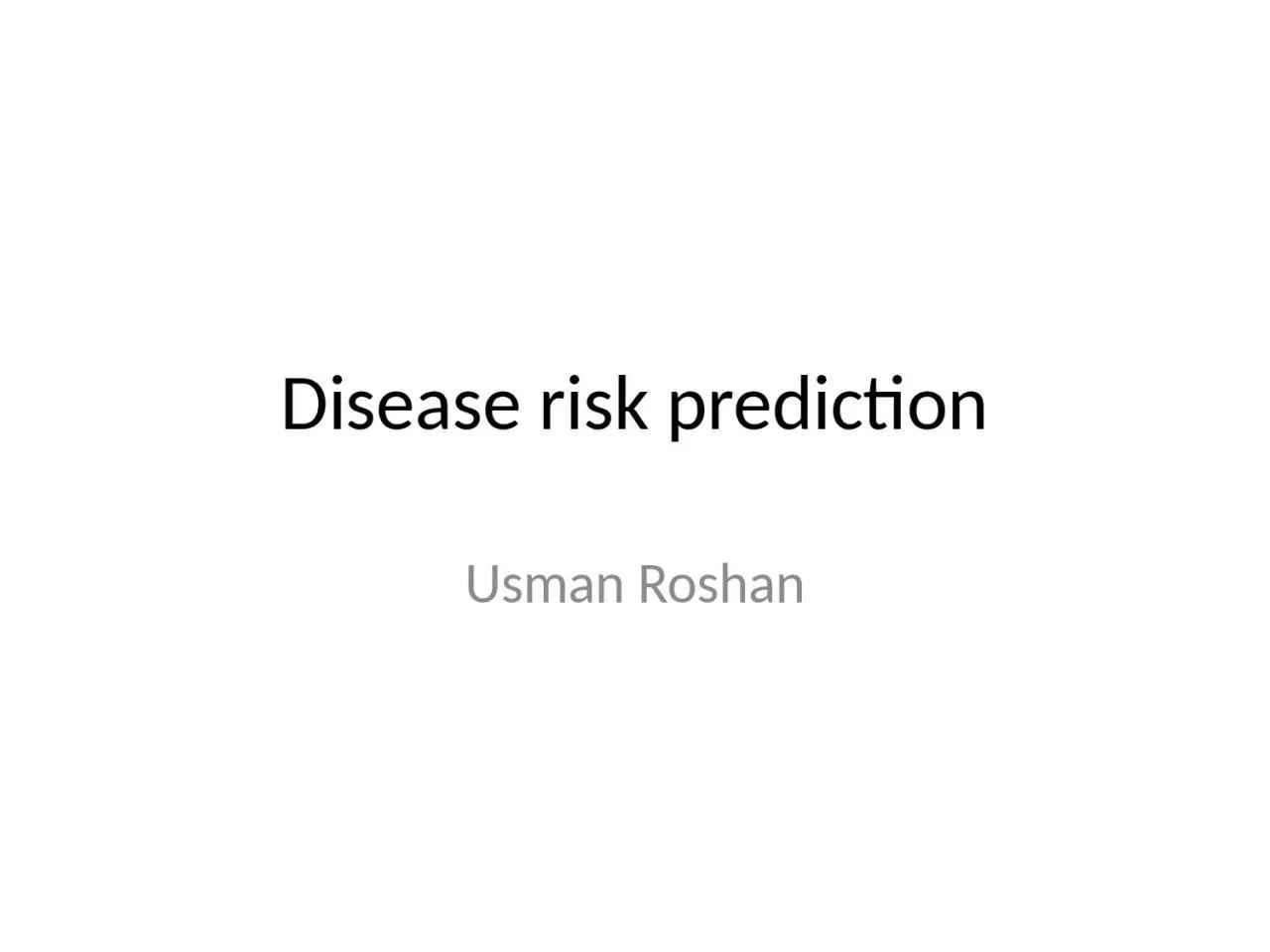

Roshan Disease risk prediction Prediction of disease risk with genome wide association studies has yielded low accuracy for most diseases Family history competitive in most cases except for cancer Do et ID: 933570
Download Presentation The PPT/PDF document "Disease risk prediction Usman" is the property of its rightful owner. Permission is granted to download and print the materials on this web site for personal, non-commercial use only, and to display it on your personal computer provided you do not modify the materials and that you retain all copyright notices contained in the materials. By downloading content from our website, you accept the terms of this agreement.
Slide1
Disease risk prediction
Usman
Roshan
Slide2Disease risk prediction
Prediction of disease risk with genome wide association studies has yielded low accuracy for most diseases.
Family history competitive in most cases except for cancer (Do et.
al., PLoS Genetics, 2012)
Slide3Disease risk prediction
Our own studies have shown limited accuracy with various machine learning methods
Univariate
and multivariate feature selectionMultiple kernel learningWhat accuracy can we achieve with machine learning methods applied to variants detected from whole exome data
?
Slide4Chronic lymphocytic leukemia prediction with
exome
sequences
and machine learningWe selected exome sequences of chronic lymphocytic leukemia from dbGaP
. Largest at the time of download in August 2013.
186 cases and 169
controls
Case and control prediction accuracy with genetic variants unknown
Same dataset previously studied in Wang
et.
a
l.
,
NEJM, 2011 where new associated genes are reported but no risk prediction
Slide5What is whole exome
data?
Human genome sequence
Illumina
76bp short reads (
exome
data).
In practice flanking regions are also sequenced
and so some
intronic
regions are included.
Exons
Coding regions
Introns
Slide6Obtain structural variants (1)
Data of size 3.2
Terrabytes
and 140X coverageMapped to human genome reference with BWA MEM (popular short read mapper)
Human genome reference sequence
Short reads are aligned to human genome
Slide7ACC
A
G
ACC
A
G
ACCAG
ACC
C
G
ACC
C
G
Heterozygous
SNP encoded
as 1
ATT
--A
ATT--A
ATT--
AATT
GA
ATTGA
ATTGAHeterozygous
indelencoded as 1
ATTGA
Human genomereference
Short reads from a
single individual
ATT
GA
ATTG
AATT
GA
ATTGA
ATTGAATTAA
Homozygous SNPencoded as 2 (0 if
same as reference)ATT
GA
(2, 1, 0, 1)
Encoded into a feature
vector of four dimensions
ACCAG
ACC
AG
ACCAG
ACCA
GACC
AGACC
AG
Here no variant is reported but we detected it in a different individual. Thus we assign it a value of 0 for this individual.
Slide8Obtain structural
variants (2)
Obtained SNPs and
indels from the alignments for each individual
ACC
A
G
ACC
A
G
ACC
A
G
ACCAG
ACC
C
G
ACC
C
GACC
CG
Heterozygous SNP encoded as 1
ATT--A
ATT--A
ATT--A
ATTGA
ATTG
AATTGA
Heterozygous indel
encoded as 1
ATTGA
Human genomereference
Short reads from a
single individual
ATT
GA
ATT
GA
ATTGA
ATTGA
ATTGA
ATTGA
Homozygous SNPencoded as 1 (0 if
same as reference)
ATTGA
Slide9Obtain structural
variants (3)
A/C C/G
A/C C/G C0 AA CC C0 0 0C1 AC CG C1 1 1
C2 AA GG C2 0 2
Co1 AC CG Co1 1 1
Co2 CC CG Co2 2 1
Combine variants from different individuals to form a data matrix
Each row is a case or control and each column is a variant
153
cases and
144
controls after excluding very large files and problematic datasets
122392 SNPs and 2200
indels
Numerically encoded
Slide10Perform cross-validation study
Training data
Validation data
Split rows randomly into training validation sets (90:10 ratio).
Rank all variants on training
Learn support vector machine
classifer
on training data with top
k
ranked variants
Predict case and control on validation data.
Compute error and repeat 100 times
Full dataset: each row
is a case or control
i
ndividual and each
c
olumn is a variant
(SNP or
indel
)
0 0 1 2 0 . . .
0 2
2 2 1 . . .
.
.
.
Slide11Variant ranking
F0 F1 F2 F1 F2 F0
C0 1 2 0 C0 2 0 1C1 1 2 1 C1 2 1 1
C2
1 2 2 C2 2
2
1
Co1 1
0 1 Co1 0 1 1
Co2 2
0 0 Co2 0 0 2
Rank features
Slide12Risk prediction with Pearson
ranked
SNPs
Slide13Prediction with GWAS
Slide14Cross-study validation
Slide15Prediction on external samples
Slide16Prediction on external samples
Slide17Pearson ranking of genes associated with CLL
Slide18Analysis of top ranked Pearson genes
Slide19Conclusion
Encouraging results with
exome
dataNo known risk prediction study with exome dataLimitations: Small sample sizeAncestry of some data unknown